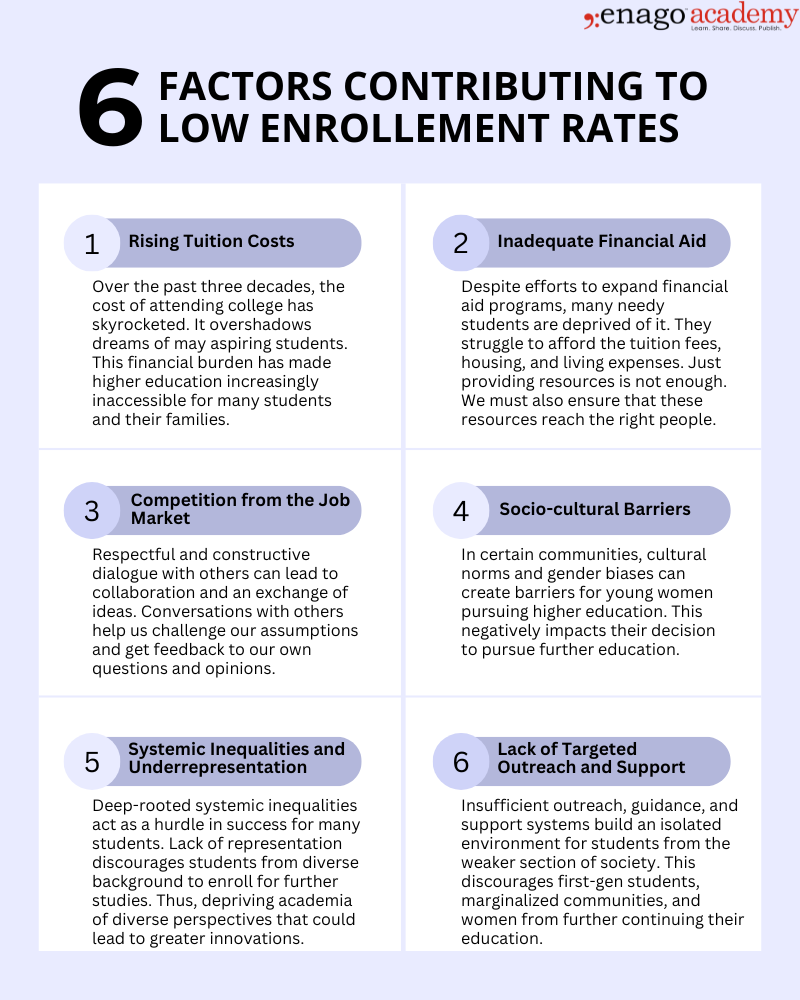
Over the past decade, colleges and universities across the globe have witnessed a concerning trend ― a steady decline in enrollment rates. The corridors of colleges, once bustling with discussions, are now quieter. According to data from the National Student Clearinghouse Research Center, undergraduate enrollment dropped by 3.5% in just one year.
This alarming pattern continues as enrollment rates decline more with each year. This impacts not just colleges but also threatens the overall growth and advancement.
6 Major Factors Contributing to Low Enrollment Rates
There has been a significant drop in the enrollment rates among BAME students from 2021 to 2022:
- Black (-7.8%)
- Latinx (-5.7%)
- Asian (-8.8%)
Women’s enrollment declined by 4.6%, compared to 3.3% for men. This indicates that socio-economic barriers are a major contributing factor to the ongoing crisis.
Six other major factors contributing to the declining enrollment rates include rising tuition costs, insufficient financial aids, competition from the job market, gender bias, systemic inequalities, and lack of targeted support.
 Strategies to Overcome the Crisis of Low Enrollment Rates
Strategies to Overcome the Crisis of Low Enrollment Rates
Overcoming this crisis requires a multifaceted approach. Each of the barrier needs to be understood and them dismantled.
Strategies to increase enrollment and promote equitable access include:
1. Improving Accessibility and Affordability
Higher education institutions must prioritize making college more affordable through initiatives such as freezing or reducing tuition fees, expanding need-based aid programs, and offering more merit-based scholarships.
2. Expanding Financial Aid Programs
Federal and state governments should invest in expanding financial aid programs. These should include need-based grants and loan forgiveness initiatives, to relax the financial burden on students and families.
3. Flexible Degree Programs
Embracing innovative educational models, such as flexible degree programs is the right way to go ahead. It can cater to the diverse needs of today’s students, including working adults and those seeking alternative pathways to higher education.
4. Outreach and Support for Underrepresented Groups
Targeted outreach, mentorship, and support programs tailored to the unique needs of first-generation, low-income, and underrepresented minority students can help break down barriers and foster a more inclusive and supportive campus environment
5. Increased Government Funding and Support
Governments must prioritize higher education by increasing funding for public institutions, supporting research and innovation, and promoting policies that incentivize enrollment and degree attainment.
Addressing the enrollment crisis also requires a collaborative effort between higher education institutions and industry partners. By building strategic partnerships with industry experts, colleges and universities can develop curricula and upskilling opportunities that align with the evolving needs of the workforce. This collaborative effort can not only attract more students by offering relevant, career-focused programs but also better prepare graduates for success in the job market.
This complex challenge demands immediate and targeted action from all stakeholders. By addressing cost barriers, embracing innovative educational models, and supporting underrepresented communities, we can address it appropriately. We can all come together and pave the way for a future where higher education is accessible and equitable.









![What is Academic Integrity and How to Uphold it [FREE CHECKLIST]](https://www.enago.com/academy/wp-content/uploads/2024/05/FeatureImages-73.png)